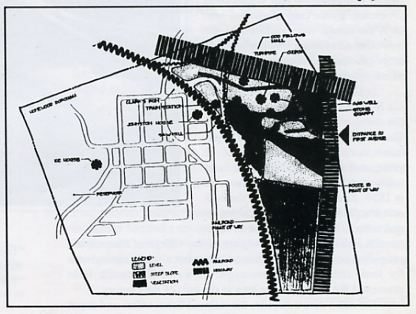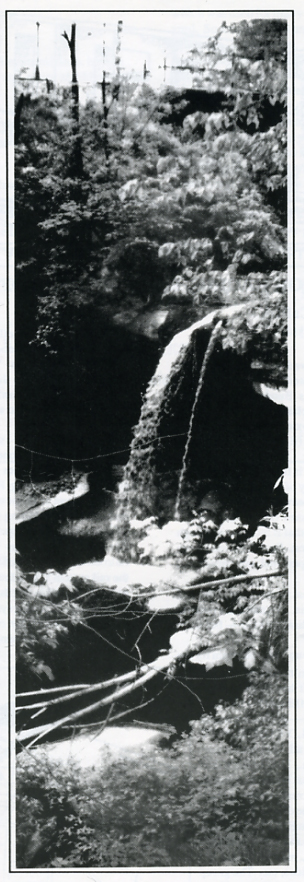
Click Here to Return to Milestones
Another county site amply endowed with the historicalrecreational combination (the basic criteria for a great tourist attraction) is Homewood, PA., with its Buttermilk Falls area currently being studied under a master plan grant.
Homewood is one of those paradoxical places. For those who have never had a reason to go there (it is off the mainstream routes), it just doesn't "ring a bell."
But talk to a native or someone who is familiar with the town and its history, and you will hear a variety of stories and antidotes that "sing praises of its charms to high heaven." After talking to these persons for a while, the town takes on the aura of the legendary Brigadoon or Shangri-la, and that is more than enough to pique the curiosity of the average person. So, we decided there was only one way to make an unbiased personal assessment and that was to check the town out.
The Heritage Days Festival held last year on Oct. 10th and I Ith seemed to be the ideal time to do this. We made it a point to go on Sunday afternoon. We were not disappointed - but there was one regret.
After reading the entertainment lineup in the program for the proceding day we were sorry that we didn't come on that day also and enjoy its musical offerings. It had, for example, starting at 11:00 a.m., THE MEN OF MELODY - old time favorites; at 12:30, JUMIP THE FENCE - Blue grass music at its finest! 2:00 -p.m., The CANFIELD COMMUNITY BAND - featuring Sousa marches and all American favorites - 50-piece concert band; 4:00 p.m., DIE LUSTIGEN TTROLER BAND - one of Ohio's finest bands with music ranging from traditional, polkas and waltzes to contemporary latin tempos. And the final offering of the day was "Dancing to the Big Band Sounds - Smooth" of the EDDIE FRASIER ORCHESTRA frorn 8:00 p.m. to 11:30 p.m. Who could have asked for anything more? But there was ... mainly dinners and food booths, crafts, displays, contests, rides, etc. The group we saw Sunday at 2:00 p.m., BEAVER CREEK BAND - blue grass and old time country with cloggers - was just great. But let us back up a little here and "tap in" to the Master Plan that was authorized by the Homewood Council and the County Commissioners to get a better overall picture of what the potential is at Buttermilk Falls.
Although a lot of excellent research goes into these plans, the general public usually does not have easy access or the inclination to read and study them. We present the chapter on development (its history) here from the Master Plan that PASHEK ASSOCIATES, a consulting firm from Pittsburgh was hired to make in hope that it will lead to a better understanding of the project.

The Homewood Stone Quarry, located downstream from the falls, was one of a series of productive quarries along the Beaver and Connoquenessing Rivers. A work force of 100 persons quarried stone at Homewood for use in roads, bridge abutments and buildings including the Western Penitentiary.
The extraction of quarry stone and bituminous coal in Big Beaver Township was stimulated by the construction of the railroad in 1852. Quarries were established in close proximity to the rail system where the heavy stones could be transported with ease. It is possible that the Homewood sandstone was used for the Pennsylvania Canal, a system that required immense quantities of high quality stone for construction of locks and walls. Early railroads also used sandstone quarry blocks for bridges and massive support walls. The "touch" marks used by early stone masons can still be seen on rail construction sites in the county.
Regional transportation systems were important in the development of the Homewood. By 1834, the eastern states were, connected to the Mississippi Valley by two canal systems, the Pennsylvania and Erie Canals. Legislators envisioned a canal to connect the two major systems to create a continuous waterway. Proposals of a rail system to join the waterways was overturned, and in 1831 engineers began designs for the new canal. The Beaver Division of the Pennsylvania Mainline Canal originated at the juncture of the Beaver and Ohio Rivers and continued north on Beaver River through the Homewood area to the Shenango slackwater above New Castle. At this point, the canal continued by way of the Shenango River to Conneaut Lake and Lake Erie. The Ohio River formed the junction between the Beaver Division and the Main Line at Pittsburgh. The canal ran over an expanse of 136 miles and required 137 locks to overcome a total rise of 977 feet. At one time there were also 13 dams, 9 aquaducts, 30 basins and 221 crossing road-bridges (Corkan 1937).
The Beaver Division provided the link between Great Lakes and Mississippi River trade networks and became a catalyst for growth and development of many towns along its route. However, the canal was plagued with inefficient management and engineering problems. By the mid-nineteenth century, the canals were replaced by the new railroad systems which provided a more efficient and economical method of transportation,
In 1852, the Ohio and Pennsylvania Railroad was constructed through the developing village now known as Homewood. The community's population increased during the next seven years until Joseph M. Smith, an early landowner in the area, laid out the town in 1859. Smith had purchased the 200 acre tract at Homewood from historian and author, William Grimshaw. Buttermilk Falls was an integral part of the village of Homewood providing not only a water power source but a scenic natural area for local recreation. Stereoscopic views of Buttermilk Falls preserved the beauty of the area at the turn of the century.
For more than a decade, the railroad ticket office and depot at Homewood were housed in the bar room of the Johnston House, a local hotel situated on the main line. In 1864, the Fort Wayne Railroad finally constructed a station overlooking the falls (DeSanzo:n.d.). The station was situated to the east of Main Street between the juncture of the Pittsburgh, Fort Wayne, and Chicago Railroad and the Pittsburgh, Youngstown and Ashtabula Railroad (Thompson and Lindeman: 1930).
One year before the town was laid out, the Homewood Iron Furnace went into blast on the east shore of the Beaver River opposite Homewood. James Wood produced pig iron at the site for nearly a decade until the furnace went out of blast in the late 1860's after the Civil War. Two earlier and short-lived Beaver County furnaces - the Beaver Falls Furnace and the Bassenheim Furnace - were constructed in the early nineteenth century and failed after the economic depression following the War of 1812 (Sharp and Thomas: 1966). As the demand for iron increased before the Civil War, Pennsylvania iron masters experienced a major expansion with many new furnaces or older refurbished furnaces placed into blast. The renewed interest in Beaver County iron making resulted from this increase in the need for pig iron as well as the improved rail transportation in the area (Davis: 1988).
In 1869, Homewood was noted as the juncture of the Fort Wayne Railroad's branch proceeding north to Erie and the second branch continuing to Chicago. "A few stores, a sawmill, hotel and post office" were the only "improvements worthy of mention." 'Me local post office served all of Big Beaver Township for many years. The Homewood Methodist Episcopal Church established in 1869 also functioned as the community's school until a one-room school was constructed in 1870. In 1915, a two-story brick building replaced the old school. The "firstclass" general store was managed by J.C. Evans who offered dry goods, notions, groceries and provisions at "Prices as low as the lowest" (Weyland and Reed: 1876). In 1876, the Johnston House, later the St. Cloud Hotel, advertised the following message:
"Boarding by the week, day or meal, at reasonable rates. Table supplied with the best the market affords. Choice wines, liquors, and cigars constantly on hand. Give us a call."
T.M. Miller, Proprietor
By 1870, Big Beaver township had a population of 1,559 persons. In Homewood, 61 heads of household were listed. Masons and laborers who were employed by the Homewood Quarry dominated the directory list. The remainder of the work force was composed of three blacksmiths, four shoemakers, seven carpenters, two section bosses and the proprietor of the Johnston House. However, by 1876, the major of workers in the township were farmers and laborers. Only three persons were involved in die quarrying of stone.
Other local economic in the town included several dry goods stores and a broom factory located opposite the street from the church. The Homewood Ice House, owned by Web Hunter, was situated at the Homewood Reservoir and eventually employed 30 workers. A horse-drawn plow was used to cut the ice from the pond. Ice blocks were then cut into smaller sections and moved via a track to the ice house where it was packed in sawdust. The flammable nature of the sawdust caused spontaneous combustion resulting in a major fire that destroyed the ice house in 1914.
The Pittsburgh, Harmony, Butler and New Castle Railway Company provided an inter-urban transportation network between Pittsburgh and communities located to the west of the city. The line was constructed in 1908 during a time of renewed interest in interurban trolley lines. Poor road conditions, the small number of automobiles in the county, and the need for passenger transportation among local communities resulted in the construction of the new system. The line transported passengers between Pittsburgh and Youngstown, Ohio, as well as providing service for the Wells-Fargo Express. The Harmony Route offered access to local recreational facilities such as Homewood Falls and Rock Point Park near Ellwood City. The Route also made a private stop at the Ellwood City Country Club and golf course.
Uniting the east and west shores of the Beaver River was an important connection on the new transportation system. On November 5, 1914, the Harmony Line Bridge was completed at a cost of $160,000 to carry the line across the Beaver River above Homewood. The bridge was 800 feet long, 36 feet wide, and provided space for the tracks, two teams, and a sidewalk (History of Ellwood City: 119). A dangerous railway crossing at Homewood was alleviated by a costly viaduct over the line.
Between 1924 and 1930, automobile ownership dramatically increased and ridership on the local trolley lines declined. After the Harmony Short Line had operated for six months in receivership, the Federal District Court ruled that service on the Harmony Line be discontinued as of August 15, 193 1.
On September 12,1910, the community of Homewood was incorporated as a borough after a majority of residents petitioned the court in July of that year. The town was renamed Racine ca. 1928. Construction of the Pennsylvania Turnpike onthe northern border of the town in the 1940's altered the once rural environment around Homewood.
A renewed interest in the beauty of Buttermilk Falls occurred in the 1970's when Paul Weigman of the Western Pennsylvania Conservancy evaluated the Fans. The 1987, Buttermilk Falls was included on the Western Pennsylvania Conservancy's list of "Outstanding Scenic Geological Features of Pennsylvania."
